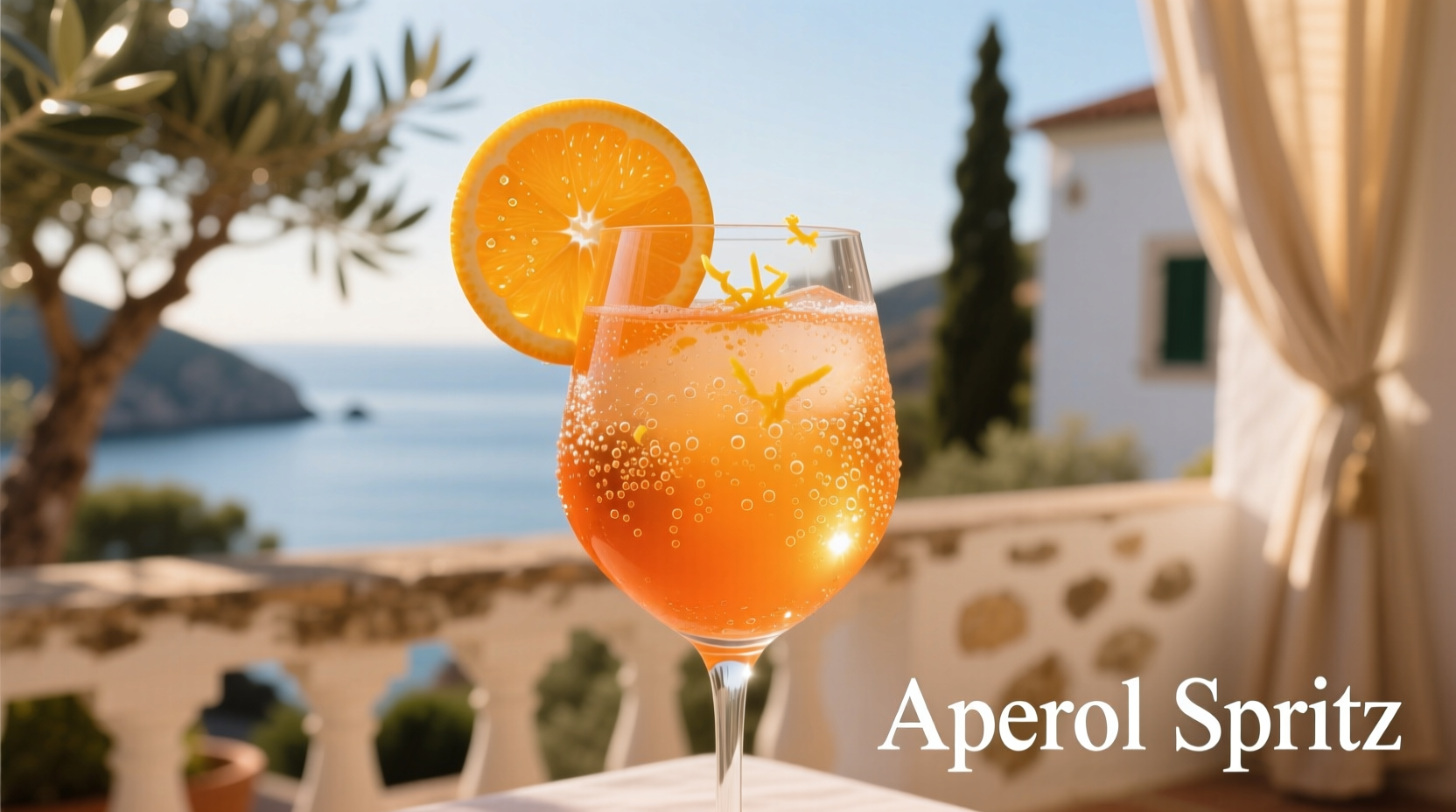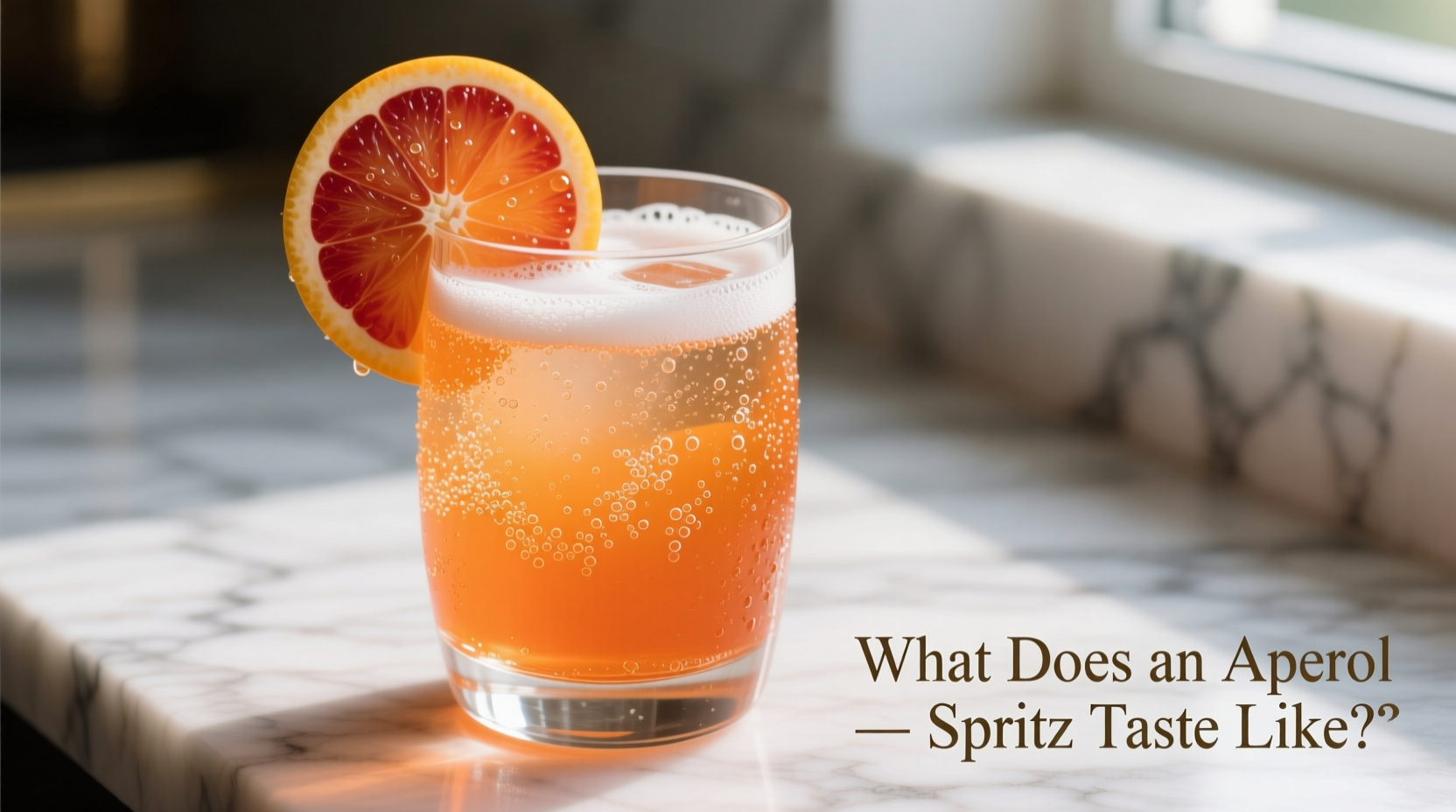An Aperol Spritz delivers a refreshing, approachable flavor profile characterized by vibrant orange citrus notes balanced with gentle bitterness, subtle herbal complexity, and light sweetness. This Italian aperitif combines the distinctive bitter-orange liqueur Aperol with Prosecco's crisp effervescence and a splash of soda water, creating a light, sessionable cocktail with an ABV of approximately 11% that's perfect for warm afternoons and social gatherings.
Your Complete Flavor Journey Through an Aperol Spritz
First Sip: The Immediate Sensory Experience
When you take your first sip of a properly made Aperol Spritz, you'll immediately notice a refreshing burst of orange flavor—think blood orange rather than sweet navel orange. The initial impression is bright and citrus-forward, with subtle floral notes from the Prosecco. Unlike more intense bitter liqueurs, Aperol's bitterness is温和 and approachable, registering around 110 bitter units compared to Campari's 330. This measured bitterness creates a refreshing contrast that awakens the palate without overwhelming it.

Flavor Breakdown: What Creates That Signature Taste
The distinctive taste of an Aperol Spritz emerges from the careful balance of three components:
| Ingredient | Flavor Contribution | Key Components |
|---|---|---|
| Aperol (3 parts) | Bitter-orange base with herbal complexity | Bitter orange, gentian, rhubarb, cinchona |
| Prosecco (2 parts) | Crisp acidity and delicate fruit notes | Green apple, pear, citrus zest |
| Soda Water (1 part) | Light effervescence and palate cleansing | Neutral carbonation that lifts flavors |
Why Temperature Matters: The Science of Serving
According to research from the University of Gastronomic Sciences in Pollenzo, Italy, serving temperature significantly impacts your perception of an Aperol Spritz's flavor profile. When served between 8-10°C (46-50°F), the bitter compounds in Aperol become less pronounced while the citrus notes remain vibrant. Warmer temperatures increase the perception of alcohol and bitterness, while excessively cold temperatures can mute the delicate herbal notes. This explains why authentic Italian bars always serve Aperol Spritz over plenty of ice rather than with just a few cubes.
Regional Variations and Their Flavor Impact
While the classic Venetian recipe maintains a 3:2:1 ratio (Aperol:Prosecco:soda), regional variations across Italy create distinct taste experiences:
- Northern Italy: Uses higher-quality DOCG Prosecco, enhancing floral notes and creating a more refined finish
- Rome variation: Substitutes sparkling white wine for Prosecco, yielding a drier profile with less fruitiness
- Southern adaptation: Adds a dash of orange bitters, intensifying citrus notes while preserving balance
Food Pairing Wisdom: Enhancing the Experience
Culinary experts at Slow Food International note that the Aperol Spritz's moderate bitterness makes it exceptionally versatile with food. The bitter compounds interact with umami receptors, cleansing the palate between bites. For optimal pairing:
- Antipasti: Prosciutto-wrapped melon (bitterness cuts through fat)
- Seafood: Grilled shrimp with lemon (citrus notes complement)
- Cheeses: Fresh mozzarella (bitterness balances creaminess)
- Vegetables: Marinated artichokes (herbal notes enhance)
Avoid overly spicy foods that can amplify the alcohol perception, and steer clear of intensely sweet desserts that clash with the cocktail's bitter profile.
Common Misconceptions About Aperol Spritz Flavor
Many believe Aperol Spritz is simply "sweet and orangey," but this oversimplifies its sophisticated profile. The European Food Safety Authority's analysis of Aperol's composition reveals over 20 botanical compounds contributing to its complexity. The gentian root provides earthy undertones, while cinchona bark adds subtle medicinal notes that balance the orange sweetness. When properly made, an Aperol Spritz should never taste syrupy or cloying—its moderate 11% ABV and measured sweetness (110g/L) create a refreshingly dry finish.
How to Perfect Your Homemade Aperol Spritz
Professional mixologists emphasize three critical factors for authentic flavor:
- Ice quality: Use large, dense cubes that melt slowly to prevent dilution
- Pouring sequence: Build in the glass (Aperol first, then Prosecco, then soda) to preserve carbonation
- Garnish technique: Express orange oils over the drink before adding the slice to release aromatic compounds
According to the International Bartenders Association, skipping the soda water creates an unbalanced drink that emphasizes alcohol warmth rather than the intended refreshing profile. The soda's neutral carbonation lifts the flavors and creates the signature light mouthfeel that defines an authentic Aperol Spritz experience.
Seasonal Adaptations for Year-Round Enjoyment
While traditionally a spring and summer drink, culinary experts have developed seasonal variations that maintain the core flavor profile while adapting to different temperatures:
- Winter: Add a cinnamon stick (not stirred in) for subtle warmth without overpowering
- Spring: Incorporate edible violets for floral notes that complement orange
- Summer: Use blood orange soda instead of plain for intensified citrus character
- Autumn: Add a dash of rosemary syrup (1:5 ratio) for earthy complexity
These adaptations maintain the essential bitter-orange foundation while introducing complementary seasonal elements that enhance rather than mask the signature Aperol Spritz taste profile.
Does an Aperol Spritz taste bitter?
Yes, but in a gentle, approachable way. Aperol Spritz has a mild bitterness from gentian and cinchona that balances the orange sweetness. Unlike Campari-based drinks, Aperol's bitterness registers at only 110 bitter units (compared to Campari's 330), creating a refreshing contrast that awakens the palate without overwhelming it.
Is Aperol Spritz sweet like a dessert cocktail?
No, despite its orange flavor. Aperol Spritz has moderate sweetness (110g/L) balanced by bitterness and Prosecco's acidity. When properly made, it finishes dry rather than syrupy. The perceived sweetness depends on the ratio—too much Aperol creates cloying sweetness, while the classic 3:2:1 ratio maintains refreshing balance.
How does temperature affect Aperol Spritz flavor?
Temperature significantly impacts flavor perception. Served between 8-10°C (46-50°F), the bitter compounds become less pronounced while citrus notes remain vibrant. Warmer temperatures increase alcohol and bitterness perception, while excessively cold temperatures mute the delicate herbal notes. Authentic preparation always includes plenty of ice to maintain optimal serving temperature.
What foods pair best with Aperol Spritz?
Aperol Spritz pairs exceptionally well with light Italian antipasti. Prosciutto-wrapped melon balances the bitterness with sweetness, grilled shrimp complements the citrus notes, fresh mozzarella works with the herbal complexity, and marinated artichokes enhance the earthy undertones. Avoid overly spicy foods that amplify alcohol perception and intensely sweet desserts that clash with the cocktail's profile.











 浙公网安备
33010002000092号
浙公网安备
33010002000092号 浙B2-20120091-4
浙B2-20120091-4